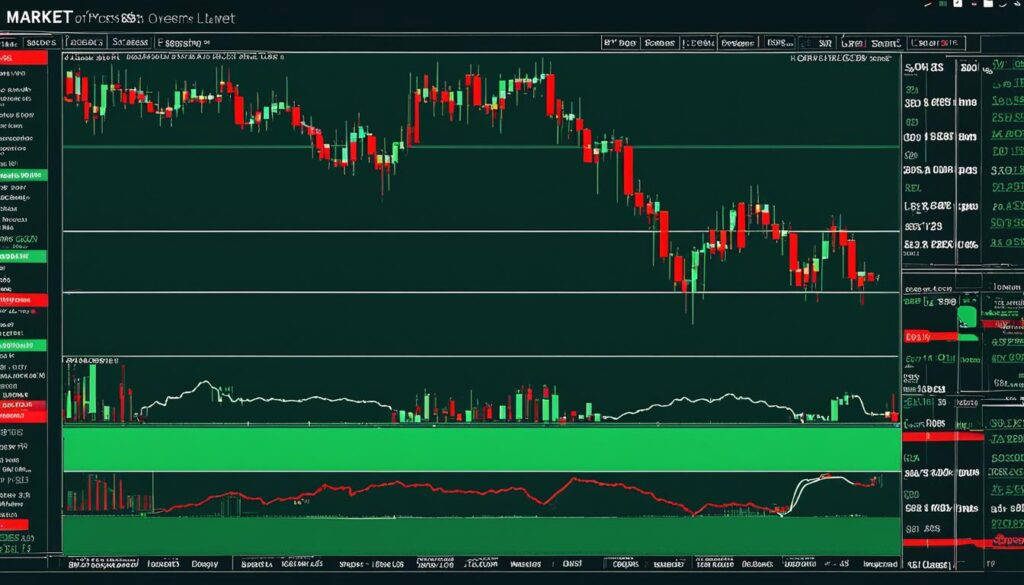What is Liquidity in Forex Trading?
Do you know that 84.9% of forex market trades are in U.S. dollars? This shows how liquid the forex market is. It’s the most liquid market in the world. This is due to large trading volumes and frequent trades. Liquidity matters a lot in forex because it helps transactions happen without big changes in prices. So, it’s key for all traders.
Liquidity means trades happen fast and smoothly. This offers quick order completion and smaller price differences. High liquidity is great for major currency pairs like EUR/USD and USD/JPY. It means traders can buy or sell without much risk. But, low liquidity at odd times or with less popular pairs means more risk. It’s harder to sell your currency if there are fewer people buying.
Key Takeaways
- The forex market enjoys unmatched liquidity, facilitating efficient currency trading.
- High liquidity enables faster order execution and reduces the risk of slippage.
- Major currency pairs such as EUR/USD and USD/JPY exhibit high liquidity.
- Low liquidity can increase risks, making it difficult to close positions if buyers are scarce.
- Traders should employ liquidity indicators and analyze market trends to enhance trading strategies.
Introduction to Forex Liquidity
Forex market liquidity is key for smooth trading. It allows currencies to be traded easily because there are lots of trades happening. Factors like global credit, economic happenings, and those who provide liquidity impact this.
The forex market has a daily volume of $2.4 quadrillion, making it the most liquid. This means traders can buy and sell quickly and at good prices, reducing risks. Common pairs like EUR/USD, USD/JPY, GBP/USD, and USD/CHF are very liquid. But pairs that aren’t traded often are the least liquid.
Forex liquidity changes with the world’s economy, political events, and market times. Interest rate changes, big news stories, and economic surprises make the market more or less liquid. Liquidity Providers help keep things stable by always offering prices to buy or sell currencies.
| Factors Influencing Forex Liquidity | Impact on Market |
|---|---|
| Global Credit Supply | Having more money for trading increases liquidity. |
| Global Credit Demand | If fewer people want to trade, liquidity can rise. |
| Economic Events | Events like elections or disasters can change how much trading happens, affecting liquidity and prices. |
| Monetary Policies | Changes in interest rates can shake up the market a lot. |
To be a successful forex trader, understanding market liquidity is crucial. High liquidity means better deals and speedier trading. On the other hand, low liquidity can cause problems, leading to higher costs and unstable prices. This makes market liquidity a critical aspect to consider.
Defining Liquidity in the Financial Markets
Liquidity in the financial markets lets people quickly buy or sell things like stocks or money. Asset liquidity is key. It means investors can turn their investments into cash fast.
What is Liquidity?
Liquidity shows how fast we can turn something into cash without changing its price much. Think of the forex market, where over $7.5 trillion trades hands daily. Here, financial markets liquidity is crucial. The U.S. dollar, euro, yen, and other big currencies are very easy to buy and sell, making them trading liquidity leaders.

- Forex Market: Over $7.5 trillion in daily trading volume.
- Major Currencies: U.S. dollar, euro, yen, pound, Swiss franc, Canadian dollar.
- Futures Markets: Very liquid.
- Real Estate: Less liquid compared to financial assets.
- Stock Markets: New York Stock Exchange exemplifies high liquidity.
Why is Liquidity Crucial?
Liquidity and market depth are very important in financial markets. They make trading easy and cheap, helping traders quickly buy and sell. This keeps prices stable, attracting more people to trade and creating a lively market.
A market rich in trading liquidity is also less likely to suddenly change wildly. Good liquidity makes trading conditions steady, thanks to narrow bid-ask spreads. But, in places where it’s hard to buy or sell, like in small-stock markets, prices can jump around a lot.
Overall, liquidity makes markets run smoothly. It affects how cheap or easy it is to trade. Without enough market depth, trading gets hard, and prices can move against you.
Factors Influencing Liquidity in Forex Trading
Many factors affect how easily forex assets can be bought and sold without price change. Knowing these helps manage liquidity well.
Monetary Policies
Changes in interest rates and money movement greatly shape the forex market. Central banks adjust policies to keep currencies stable. For instance, raising interest rates attracts investors, boosting the availability of assets. Market interventions can also affect liquidity, based on policy goals.
Supply and Demand
The state of supply and demand influence forex liquidity. More credit or less demand increases liquidity. The London and New York trading sessions show this with high volume transactions. On the other hand, periods of geopolitical tension see a drop in trading, leading to lower liquidity.
Market Participants
Market players affect liquidity too. Retail traders and powerful institutions play different roles. Retail traders help during volatility while institutions maintain a consistent transaction flow. Liquidity providers, including investment banks, keep the market stable. This is vital for smooth trading.
| Factor | Description | Impact on Liquidity |
|---|---|---|
| Monetary Policies | Interest rates, money flow adjustments | Significantly alter currency values and liquidity levels |
| Supply and Demand | Credit supply, geopolitical events | Influence transaction volumes and liquidity |
| Market Participants | Institutional investors, retail traders, banks | Shape market activity and transaction volumes |
Understanding these elements helps traders manage liquidity effectively in the forex market.
Currency Pair Liquidity: Major vs. Exotic Pairs
To be successful in forex trading, knowing about liquidity in different pairs is vital. There are major and exotic pairs in forex, each with unique traits. These affect liquidity and how much the prices change.

Major Currency Pairs
Major pairs like EUR/USD and USD/JPY are the most traded. They have high liquidity because many people buy and sell them. Since they are popular, they have low spreads. This means the difference between buying and selling prices is small.
Trading major pairs is good for steady strategies like following trends or trading within price ranges. They are less risky because they are so stable. This makes their movements easier to predict.
| Currency Pair | Liquidity Level | Spread |
|---|---|---|
| EUR/USD | High | Low |
| USD/JPY | High | Low |
| GBP/USD | High | Low |
| AUD/USD | High | Low |
| USD/CHF | High | Low |
| USD/CAD | High | Low |
| NZD/USD | High | Low |
Exotic Currency Pairs
Exotic pairs mix a major and an emerging market currency, like USD/TRY. They are less traded and more volatile. This means prices can change a lot, and the spread, which is the difference in buy and sell prices, is wider.
Trading exotic pairs can be risky but also rewarding. If managed well, they can bring in big profits because of their volatility. For example, USD/RUB can be lucrative for traders who understand it.
- USD/TRY: High volatility, lower liquidity
- USD/ZAR: High volatility, lower liquidity
- EUR/SGD: High volatility, lower liquidity
- GBP/THB: High volatility, lower liquidity
To master trading exotic pairs, you need solid research and a clear strategy. There are different trading methods you can use. It’s best to start with one pair before trying others. This approach can make your trading in the forex market more successful.
Understanding Bid-Ask Spread and Its Impact
The Bid-Ask Spread measures the gap in prices in the forex market. It shows the difference between the price a buyer wants to pay and what a seller is offering. This gap is significant because it affects costs and trade quality.
In forex, a high number of participants and lots of trading means the Bid-Ask Spread is tiny. This tight spread benefits traders by cutting down on costs.
Yet, in less active markets, like some stocks or futures, the spread can be bigger. This situation happens with assets that are less traded. A bigger spread means higher costs for trading and lower potential profits.
The quality of executing a trade is also judged by the Bid-Ask Spread. A narrow spread means smoother and cheaper trades. But, in times of market stress, spreads might get wider. This change signals more risk and could cost more to buy or sell.
Key players called market makers help improve forex markets by offering bid and ask prices. By narrowing the spreads, they make trading more efficient. This process also helps them win more business.
Knowing how these spreads work is important for traders. It helps them lower costs and make better decisions. Things like market activity, the trade’s size, and the currency type all matter. They can help reduce the impact of high spread costs and lead to better trade results.
| Asset Type | Bid-Ask Spread |
|---|---|
| Currency Market | Fractions of pennies |
| Small-Cap Stocks | 1% to 2% |
| Options & Futures | Larger percentage due to higher risk |
To do well in trading, being smart about both liquidity and spread costs is key. Staying on top of the market and using the right trading methods can make a big difference.
Measuring Market Depth
Market depth shows how easy it is to buy or sell without changing prices much. It looks at how many trades are happening and the number of orders waiting. This tells us if the market can handle big deals smoothly. This section explains what market depth is in forex trading.

Volume of Trades
The volume of trades means the total currency traded in a set time. It’s a key sign of the market’s health. More trading shows there are many people buying and selling. But, remember, things like wash trading can make it look like a lot is happening when it’s not. Still, a high volume usually means it’s easy to trade.
Pending Trades
Pending trade orders are orders not yet filled, like limit orders. They give clues on liquidity and market depth. A lot of pending trades can absorb big deals with little effect on prices. Watching these helps traders guess how easy it is to trade and plan their moves.
| Indicator | Impact on Market Depth | Note |
|---|---|---|
| Volume of Trades | Positive | Reflects active participation and higher liquidity |
| Pending Trade Orders | Positive | Shows future market interest and liquidity availability |
High Liquidity Hours and Their Significance
Every hour in the forex market has its own advantages. However, times of peak market activity bring the most benefits. The New York and London markets meet from 8 a.m. to 12 p.m. EST, creating the best time to trade.
During these hours, more than 70% of trades happen. This high volume means better conditions for traders. Now, let’s see why this optimal trading period is key.
The New York market runs from 8 a.m. to 5 p.m. EST and is second only to London. The U.S. dollar is in 90% of all trades here. The London market, open from 3 a.m. to 12 p.m. EST, influences 43% of global trading.
When these two markets overlap, things get better for traders. They find more market activity, smaller spreads, and fast trades.
- Increased Market Movement: Having several markets open can move currency pairs over 70 pips. A single market sees about 30 pips, showing the difference.
- Lower Transaction Costs: More liquidity brings tighter spreads. This means less cost for trading, which is good news for traders who are often active.
- Predictable Price Movements: Big trading volumes help predict short-term trends. This makes it easier to take advantage of the market activity during these times.
Those open to trading at other times may enjoy the Sydney/Tokyo session (2 a.m. to 4 a.m. EST). Here, there are more movements in the AUD and JPY pairs.
| Major Trading Sessions | Trading Hours (EST) | Key Characteristics |
|---|---|---|
| New York | 8 a.m. to 5 p.m. | High liquidity, USD-centric trades. |
| London | 3 a.m. to 12 p.m. | Significant influence on currency fluctuations. |
| U.S./London Overlap | 8 a.m. to 12 p.m. | Over 70% of trades occur, optimal for trading. |
| Sydney/Tokyo Overlap | 2 a.m. to 4 a.m. | Higher pip fluctuation, trades in AUD and JPY. |
Choosing to trade during these high liquidity hours is smart. It can make a big difference in your success, especially for those who trade daily and aim to benefit from short-term changes. Knowing when to trade and why is key.
Risks Associated With Low Liquidity
Low liquidity in the forex market brings many risks. It’s important for traders to know these risks. This knowledge can help reduce losses and make trading strategies better.

Slippage
In low-liquidity times, slippage is a big issue. It’s the difference between the expected and actual trade prices. Market slippage not only changes entry points. It also affects exit points, leading to less good trade results. This can majorly impact both profits and losses, especially during low-liquidity periods.
Wider Spreads
When liquidity is low, bid-ask spreads get wider. This means higher trade costs and lower profits. Watching these spreads is crucial for traders. They show how efficient the forex market is. Wider spreads can reduce how much money a successful trade makes.
Execution Delays
Execution delays are another big risk in low-liquidity times. A delay happens between starting a trade and it being completed. Execution risk matters because it can lead to missing chances or not closing bad positions quickly. Quick and smooth execution is key to successful trading and reducing losses.
Knowing and dealing with Low Liquidity Risks is vital for forex traders. Managing liquidity well can lead to better trading results and improve efficiency.
Liquidity in Forex Trading: Key Considerations
Market liquidity is key for successful strategic trading. It directly affects how the market moves and the cost of trading. This impacts when you buy and sell in a trade. Let’s dive into the key points:
First, knowing about the Forex liquidity strategy helps in understanding trading’s big picture. It shows how each currency pair and time of day affects your trading success. High liquidity usually means your trades go through quickly and with fewer issues, which helps a lot when prices are changing fast. For instance, looking at trading volumes on platforms like EBS and Reuters from 2013 to 2016 tells you a lot about what to expect, aiding your decisions.
Then, we look at liquidity pools and big financial players. The influence of non-bank sources in recent times has changed the game. It’s important to pick providers that are both financially secure and follow the rules, while also using the latest tech. This way, you get access to more options for trading.
- Market analysis: Use indicators and volume analysis to find the best times to trade.
- Trading times: Pick times when the market is busy to save on costs.
- Understanding costs: Different providers have varying fees such as brokerage and spread costs.
- Customer trends: More people are moving towards platforms that offer everything from start to finish.
Also, think about how tech and rules change the forex world. Since 2015, there’s been less trading and more unexpected changes in prices. This means you need a smart plan for trading. Even though prices can change quickly, the rewards of trading haven’t increased as much, making it a bit riskier.
| Provider | Volume Change (2013-2016) | Comments |
|---|---|---|
| EBS | -30% | Being the main market affects volume |
| Reuters | -25% | Less trades and benchmarks |
| Hotspot | -3% | A smaller decrease |
In short, understanding the liquidity of different currency pairs and using the right tools for market analysis are crucial for strategic trading. You also need to know the importance of different liquidity sources. This is all part of winning in the changing forex market.
Conclusion
Understanding the Forex liquidity importance is key for currency traders. The market has $918.4 billion in daily transactions as of April 2023. This shows lots of trading, making it easier to buy and sell without big price swings. It also means trading big currencies costs less because their prices change smoothly.
Forex’s high liquidity helps traders see good market insights by letting them compare today’s trading with the past. This comparison helps spot trends. Liquid markets have steady prices. But, if a market is not liquid, its prices might jump or drop suddenly. This can really change how trading goes.
Keeping an eye on big liquidity signs and tools like Bollinger bands and RVI is useful. High liquidity ensures trades happen fast and as you expect. This way, you lose less money because trades go through quickly and smoothly. The best trading happens when the US and European markets are both active. So, it’s good to trade during these times and stay updated with the news.
